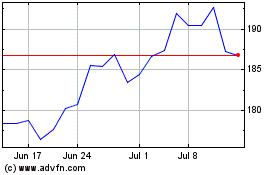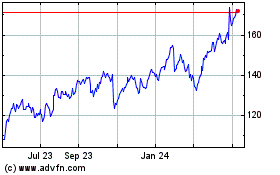By Jack Nicas and Shalini Ramachandran
Google's YouTube on Tuesday unveiled a web-TV service that will
offer a package of over 40 broadcast and cable channels for $35 a
month, making the tech giant the latest entrant in a race to win
over millions of consumers who are shifting away from traditional
TV.
The new service, dubbed YouTube TV, is set to launch in the next
few months. It will have all the major broadcasters, including ABC,
CBS, NBC and Fox, as well as several dozen well-known cable
channels, such as ESPN, FX, USA, MSNBC and Fox News.
Google, which is owned by Alphabet Inc., joins a crowded field
of companies selling "skinny bundles" of TV channels over the web.
They're targeting the rising numbers of "cord cutters," people who
cancel their pay-TV connections, as well as "cord nevers," young
people who have never paid for traditional TV. Pay-TV executives
say there is a market of at least 10 million homes that only
subscribe to broadband and not TV.
"There's no question millennials love great TV content," said
YouTube Chief Executive Susan Wojcicki. "But what we've seen is
they don't want to watch it in the traditional setting."
Other companies offering cable-style online-TV services include
traditional operators like Dish Network Corp.'s Sling TV and
AT&T's DirecTV Now, as well as new entrants like Sony Corp.'s
PlayStation Vue and Hulu, which plans to launch a streaming skinny
TV bundle soon for under $40 a month. Amazon.com Inc. has also been
discussing plans for its own bundle with media companies.
So far, none of the existing web-TV offerings have been runaway
successes, with some, such as DirecTV Now, facing technical hiccups
and other issues early on. Analysts estimate that Sling TV, which
launched first, has about 1.2 million subscribers today. A big
issue for all companies launching skinny bundles is to secure
rights to enough major TV channels while keeping the price in
check.
For media companies, having at least their big channels included
in skinny bundles is a vital hedge against the continuing decline
of traditional TV packages. The networks YouTube announced as
partners didn't include channels owned by Viacom Inc., including
Comedy Central and MTV; Time Warner Inc., including CNN, TNT and
HBO; Discovery Communications Inc.; AMC Networks Inc.; and Scripps
Networks Interactive, owner of Food Network.
Discovery, Viacom, AMC and Scripps are in talks with YouTube to
be added to the service, people familiar with the discussions said.
A Time Warner representative had no immediate comment.
"We're always in conversations with partners," said Robert
Kyncl, YouTube's chief business officer. He said YouTube doesn't
plan to increase the base price of the service if it adds new
partners.
For Google, the new service is an opportunity to build YouTube
into a bigger contributor to its business and put itself once again
at the center of changes in commerce and media consumption.
The company's search engine handles about 93% of internet
searches, according to market researcher StatCounter, and its
Android software backs 88% of the world's smartphones, according to
Strategy Analytics. Its giant ad business accounted for 88% of
parent Alphabet's $90 billion in revenue last year.
YouTube users now clock more than a billion hours a day watching
its videos, a 10-fold increase from 2012, but the site's financials
are unclear. It broke even in 2014, and executives still say growth
-- not profits -- are the priority.
The $35-a-month price for YouTube TV is aggressive, given the
premium content costs for new entrants into television
distribution. Analyst Michael Nathanson said Google will likely be
paying about $30 in content costs with its current TV lineup, and
if it adds other major channels, it is unlikely Google would run a
profit on subscription payments alone.
But he said Google's primary play with YouTube TV is to "break
into the in-home and television advertising market," selling
targeted advertising in the network ad slots that typically go to
cable operators. That could be significant as the company
increasingly targets the roughly $70 billion spent annually on TV
ads.
YouTube makes most of its money selling ads, but it has also
launched a $10-a-month, ad-free subscription service that offers
access to premium shows.
YouTube's pitch for the new service focused on subscribers'
ability to watch content on any screen -- from smartphones to TVs
-- and to record an unlimited amount of content for up to nine
months. The company said it would launch the service in the biggest
U.S. markets "in the next few months" and expand gradually after
that.
A YouTube TV subscription includes access to six accounts with
separate login information, but a maximum of three users can watch
simultaneously.
YouTube declined to say which markets will receive the service
first. It said it has partnerships with local TV stations in New
York, Los Angeles, Chicago and Philadelphia.
YouTube said the service will only be available in the U.S.
Write to Jack Nicas at jack.nicas@wsj.com and Shalini
Ramachandran at shalini.ramachandran@wsj.com
(END) Dow Jones Newswires
February 28, 2017 18:19 ET (23:19 GMT)
Copyright (c) 2017 Dow Jones & Company, Inc.
Alphabet (NASDAQ:GOOG)
Historical Stock Chart
From Mar 2024 to Apr 2024

Alphabet (NASDAQ:GOOG)
Historical Stock Chart
From Apr 2023 to Apr 2024
